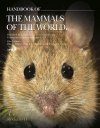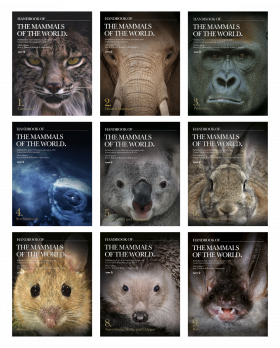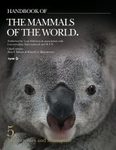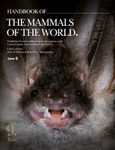Authoritative, an invaluable reference
By
Gehan de Silva Wijeyeratne
12 Apr 2020
Written for Hardback
In this review, I have covered two volumes together as the rodents which are the bulk of the content are split into two parts within the two volumes. Volume 6 in the Handbook of the Mammals of the World series covers Lagomorphs (hares, rabbits etc.) as well as the first part of Rodents. Volume 7 covers the rest of the rodents. I have reviewed some of the volumes in this series before. But every time I receive a new volume, I am amazed by the scale and ambition of this epic project. When you hold one of these books, you are holding a piece of zoological history as it surpasses all previous efforts to comprehensively document and illustrate the extant mammals of the world.
Admittedly, lagomorphs and rodents do not excite the public imagination in the way big cats and primates do. If at all, rodents suffer from bad press thanks to the House Rats and Brown Rats in our villages and towns. But these undesired rodents belong to just one family of a significant mammalian radiation. The rodents represent one of the most species-rich mammalian groups which unfortunately are out of sight and mind for most people. The stunning imagery in these volumes may help to convince some that even the rats and mice can be likeable. If it were not for our association of them with disease, many of them would be accepted as looking rather endearing. Perhaps it is just as well for their conservation that other than for a few exceptions they are not popular as pets. As it is, 89 species are noted as being consumed, in the excellent essay in volume 6 introducing the evolution, phylogeny, ecology and conservation of the lagomorphs and rodents.
The series is underpinned by strong science and in particular an effort to understand and articulate evolutionary relationships as understood at present, using molecular phylogenetics. They complement field guides which necessarily have to be concise and lightweight. Last year, I was in the USA and using a field guide to mammals of North America. I was aware that the rats and mice in the USA were in an entirely different family (Cricetidae) to the family of the rats and mice I was familiar with (Muridae) when I grew up in Sri Lanka. The family relationship charts in the series are a great help in understanding these family relationships which in everyday parlance are seen as one homogenous group of rats and mice. A good example of a chart is the one for the Cricetidae on page 205 in volume II. It illustrates in a very simple way how the family comprises five subfamilies within which are 27 tribes. The summary text box contains details that these tribes hold 765 species in 142 genera. The summary text box also contains a distribution map which makes clear the family is not just ‘New World’ (although some tribes will be confined to the New World) but extends across Eurasia to include species such as voles which I am familiar with from my other home in Britain.
The two volumes follow the standard format for the series. A few preliminaries are followed by expansive family introductions which are grouped under standard categories including Systematics, Morphological Aspects, Habitats, General Habits, Communication, Food and Feeding, Breeding, Movements, Home Range and Social Organisation, Relationships with Humans and finally Status and Conservation. These sections are interspersed with stunning images of a generous size afforded by the larger encyclopaedia size of the pages. Some images occupy a full page combining a coffee-table presentational format to a book underpinned by solid science, but written in an accessible and interesting way. As someone who writes and photographs for field guides, I find the systematics section very interesting but others may find the behavioural sections more interesting. The family accounts are followed by the species accounts where a plate illustrating several species is followed by species accounts using several standard headings (e.g. Taxonomy, Distribution, Descriptive Notes, Habitat etc.). Each species has a distribution map. All of the plates are by Toni Llobet and are of a very high standard with a photo-realistic quality. For one individual to have illustrated so many mammal species must be a record in natural history illustration. As one rifles through the pages looking at the distribution maps, it appears that many of the rodents are point endemics. It may well be the case that some species are indeed confined to one valley or one mountain range. Or, it could be that this is a reflection of how little is known. Unlike with large diurnal mammals, the majority of rodents would require capture and release trapping under research permits to study them.
Volume 6 has 37 contributing authors and covers the two families in the Order Lagomorpha. Namely Ochotonidae (pikas) and Leporidae (hares and rabbits). It also covers 25 families in the order Rodentia from the family Castoridae (beavers) to the families Sciuridae (tree, flying and ground squirrels, chipmunks, marmots and prairies dogs) and Gliridae (dormice). Volume 7 with 42 contributing authors covers 9 families from Sminthidae (birch mice) to the two most familiar families, Cricetidae (true hamsters, voles, lemmings, New World rats and mice) and Muridae (true mice and rats, gerbils and relatives). Volume 7 also includes the Muroid mole-rats (Spalacidae) which use seismic communication by banging their heads on the ceilings of their burrows.
Volume 6 undoubtedly will have more popular appeal as it covers many familiar species which people would like to see including beavers, Old World porcupines, New World porcupines, and the squirrels, the majority of which are diurnal and noticed by wildlife tourists. Even species which are usually hidden from view make for fascinating reading. For example, the colony living Naked Mole-rats where a dominant breeding female suppresses the breeding development of other females, reminiscent of the social organisation in a termite colony. The content is full of endlessly fascinating information complemented by some stunning images, some simply beautiful, other images demonstrating remarkable behaviour from boxing hares leaping into the air to rodents having confrontations with predators.
Was this helpful to you? Yes No


























































